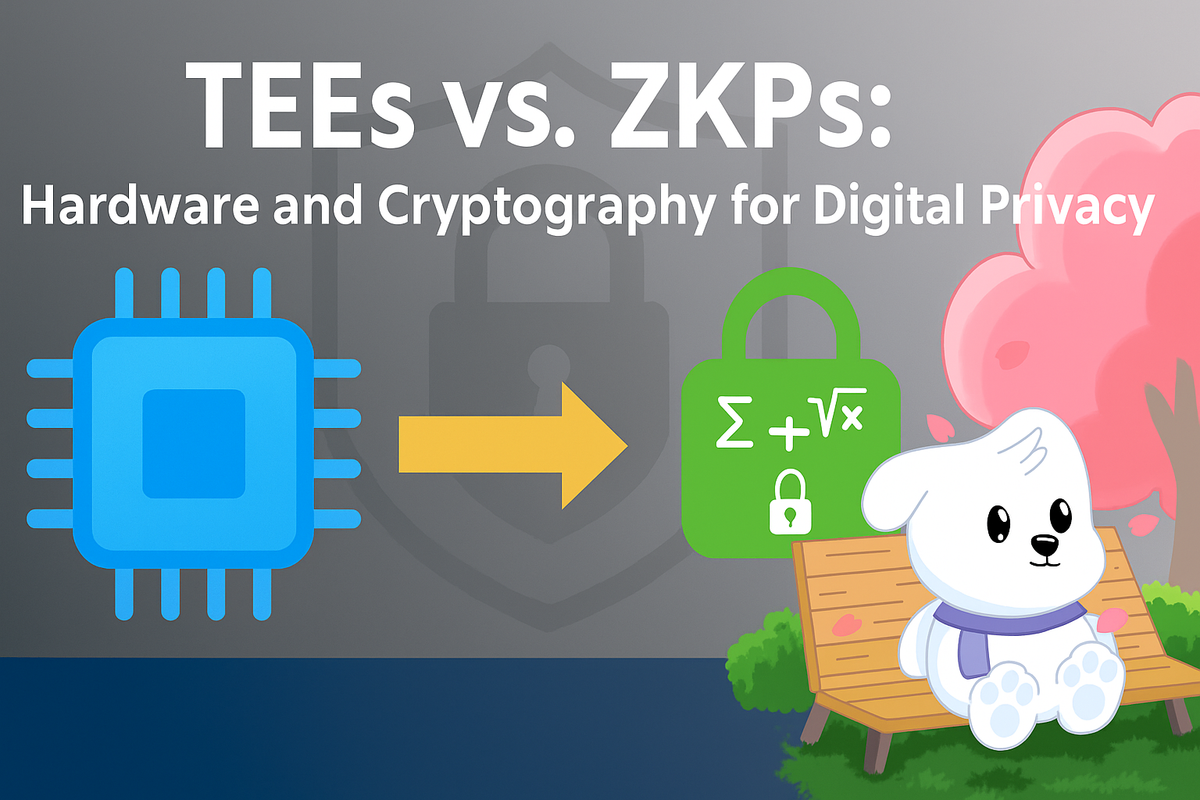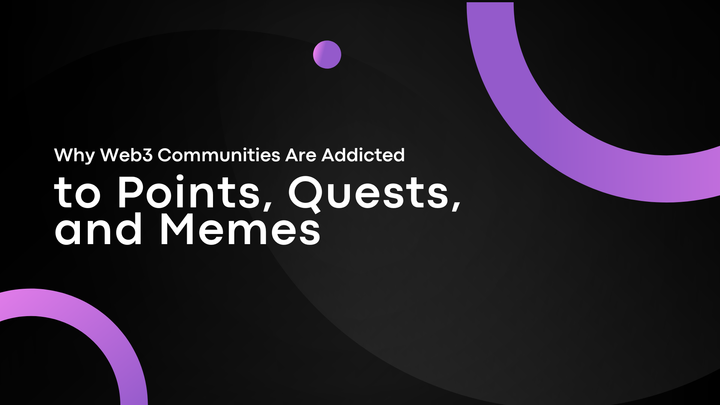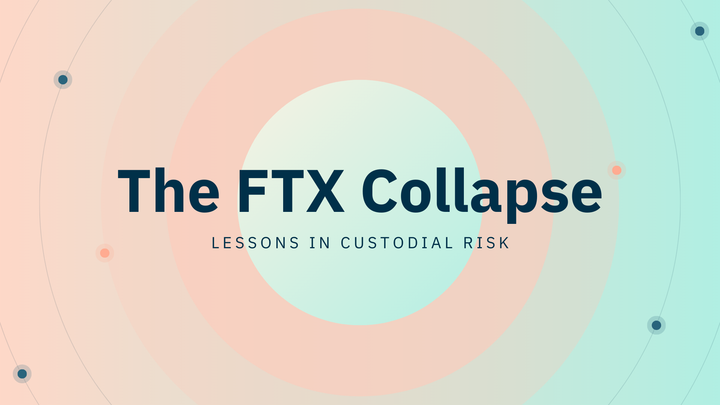TEEs vs. ZKPs: Hardware and Cryptography for Digital Privacy

Abstract
As data grows rapidly and cyber threats become more advanced, Trusted Execution Environments (TEEs) and Zero-Knowledge Proofs (ZKPs) have become key privacy tools. TEEs use secure hardware to protect data while it is being processed, and ZKPs let users prove something is true without showing the actual data. When combined especially in blockchain systems and Confidential AI, they overcome each other’s weaknesses and create stronger privacy protections. This article explains how these technologies work, where they are used, and how they help build trust and meet regulations in data-driven systems.
Introduction: The Evolving World of Digital Privacy
Today’s digital world is producing more data than ever, much of it personal and sensitive. While cyber threats like data breaches, ransomware, and identity theft are also growing. To protect users and their information, strict privacy laws such as the GDPR, HIPAA, and state laws like California’s CCPA have been put in place. Violating these laws can cost companies up to €20 million or 4% of their yearly revenue, pushing businesses to adopt privacy-enhancing technologies (PETs) to stay compliant and earn customer trust (Credence Research). In short, privacy is no longer just a legal issue, it’s a business priority.
Trusted Execution Environments (TEEs) and Zero-Knowledge Proofs (ZKPs) are key tools in this effort. They go beyond protecting stored or transmitted data they secure data even while it’s being processed. TEEs do this by creating secure spaces in hardware, while ZKPs prove something is true without revealing the underlying data. This article breaks down how these technologies work, where they’re used, and how they work together to strengthen digital privacy.
Trusted Execution Environments: Hardware-Anchored Confidentiality
Core Concepts: Hardware Isolation, Root of Trust, and Attestation
TEEs are secure areas within a processor, like a vault within a computer, designed to protect code and data confidentiality and integrity. They create enclaves, isolated memory regions where data is encrypted and only decrypted during processing, shielding it from the operating system, other applications, or device owners. This hardware isolation uses memory encryption, ensuring even privileged software, like the OS kernel, cannot access unencrypted data.
The strength of a TEE comes from its secure, trusted hardware. Private keys, written into the chip during manufacturing using one-time programmable memory, are used to verify trusted firmware like Android bootloaders or Intel SGX enclaves. This process ensures that only approved software can run and prevents attackers from faking trusted hardware (IAB).
Remote attestation allows a remote party to verify a TEE’s integrity, like checking a sealed document’s authenticity. A cryptographic proof, generated with hardware keys and a unique nonce, confirms computations occur in a genuine, untampered TEE, fostering trust for regulators (GlobalPlatform). However, attestation relies on centralized manufacturer servers, prompting proposals for verifiable proof networks—blockchain-based systems distributing trust across nodes, to enhance transparency in decentralized contexts like Web3 (ChainLight).
TEE Architecture: Isolation and Attestation
Goals: Data Protection and Regulatory Compliance
TEEs protect sensitive data by processing it in isolated environments, reducing risks of unauthorized access or leakage, even from system administrators. They align with privacy principles like data minimization (processing only necessary data), privacy-by-default (automatic protection), and accountability (verifiable audits via cryptographic logs), supporting compliance with GDPR’s Article 32 and similar laws. TEEs integrate with existing cloud computing paradigms, making them pragmatic for enterprises without requiring infrastructure overhauls.
Applications Across Industries
TEEs are widely adopted:
- Cloud Computing: Microsoft Azure, AWS, and Google Cloud use TEEs for confidential VMs and containers. AWS Nitro Enclaves create isolated environments for secure multi-tenant data processing (IAB).
- Digital Advertising: TEEs enable data clean rooms, allowing advertisers to analyze aggregated data without exposing personal information, and support confidential audience matching (IAB).
- Financial Services: TEEs secure payment processing, biometric authentication, and sensitive financial data handling (IAB).
- Mobile Devices: TEEs protect biometric data and Digital Rights Management (DRM) content, such as decrypted HD films, ensuring secure playback (IAB).
- Blockchain and Web3: Flare Networks for secure off-chain oracle computations, and ZK Layer 2 chains like Taiko, Scroll, and Ternoa for multi-proof systems with ZKPs (ChainLight).
- AI and IoT: TEEs secure edge device processing and AI model training, preventing attacks like model inversion (Phala Network).
Limitations: Hardware Dependency and Vulnerabilities
TEEs face challenges:
- Hardware Trust Dependency: Security relies on trusting manufacturers like Intel or AMD. A compromised chip design could undermine the trust model (Number Analytics).
- Centralized Attestation: Manufacturer-controlled attestation servers create a centralized trust point, less suitable for decentralized systems. Verifiable proof networks aim to address this (ChainLight).
- Side-Channel Attacks: Attacks like Prime-Probe, Spectre-like (e.g., Foreshadow), and MicroScope exploit timing, power consumption, or cache patterns to infer enclave secrets, often requiring attacker and victim code on the same CPU core (Number Analytics).
- Enclave and Control Flow Attacks: Malicious code within enclaves or speculative execution vulnerabilities can leak data. Intel notes these fall outside SGX’s threat model, as user-executed code isn’t guaranteed trusted (Number Analytics).
Zero-Knowledge Proofs: Cryptographic Verifiability
Core Concepts: Proving Truth Without Disclosure
ZKPs are cryptographic methods allowing a prover to convince a verifier of a statement’s truth without revealing additional data, like proving you’re over 21 without showing your ID. They rely on:
- Completeness: A true statement is accepted with high probability.
- Soundness: A false statement is rejected, preventing deception.
- Zero-Knowledge: No information beyond the statement’s truth is disclosed (Aztec).
This shifts from sharing full datasets to verifying specific facts, minimizing data exposure and reducing breach risks(Chainlysis).
Goals: Privacy-Preserving Transactions and Scalability
ZKPs enhance privacy and security:
- Digital Identity: Verifying attributes (e.g., age, citizenship) without sharing credentials, enabling selective disclosure for passwordless logins or age checks (Aztec).
- Blockchain Privacy: Concealing transaction details (sender, receiver, amount) in privacy coins like ZCash and Monero.
- Scalability: ZK-rollups bundle off-chain transactions into a single proof, reducing blockchain congestion and costs.
- Compliance and Fraud Prevention: Proving AML/KYC compliance without sharing sensitive data (Helius).
- Interoperability: Enabling secure data sharing across blockchain networks without full disclosure.
Types of ZKPs
ZKPs include:
- Interactive ZKPs: Require ongoing prover-verifier dialogue, less efficient (Chainlysis).
- Non-Interactive ZKPs (NIZKPs): Use a single proof message. Variants include:
- zk-SNARKs: Succinct proofs used in Ethereum smart contracts and ZCash, though some require a trusted setup (Chainlysis).
- zk-STARKs: Eliminate trusted setups, offering scalability and transparency (Chainlysis).
- Bulletproofs: Short proofs without trusted setups, ideal for range proofs (Chainlysis).
Applications and Emerging Use Cases
ZKPs transform:
- Blockchain and DeFi: ZCash and Monero hide transaction details, while DeFi platforms use ZKPs for private trading, authentication, and secure voting systems ensuring voter privacy and vote integrity.
- Digital Identity: Polygon ID enables self-sovereign identity, verifying attributes without disclosing documents.
- Supply Chain: ZKPs validate supplier credentials and product authenticity (e.g., organic certification) without exposing proprietary data.
- Medical Research: ZKPs confirm patient eligibility for studies without sharing health records.
- Biometric Security: ZKPs generate cryptographic keys from biometrics without storing originals (Helius).
Limitations: Computational and Implementation Challenges
ZKPs face hurdles:
- Computational Complexity: Generating proofs is resource-intensive, slowing transactions (e.g., zk-SNARKs take seconds).
- Trusted Setup: Some zk-SNARKs require a trusted setup, risking security if compromised.
- Implementation Complexity: ZKPs demand cryptographic expertise, challenging for developers.
- Scalability: Complex applications may face limitations despite zk-rollup advances.
- Soundness Bugs: Vulnerabilities could allow false proofs, e.g., a malicious prover faking a ZCash transaction to appear valid.
- Limited Collaborative Privacy: ZKPs focus on single-user verification, limiting multi-party computation (Biometric Update).
Comparative Analysis: TEEs vs. ZKPs
TEEs and ZKPs differ in architecture, security, and performance:
Feature | Trusted Execution Environment (TEE) | Zero-Knowledge Proof (ZKP) |
|---|---|---|
Architecture | Hardware-based, using isolated enclaves with memory encryption. | Software-based, relying on cryptographic algorithms. |
Security Model | Relies on hardware root of trust and manufacturer attestation. | Trustless, based on mathematical soundness; some variants require trusted setup. |
Performance | High throughput, low latency; proof generation in ~100ms using ECDSA verification. | Computationally intensive, slower proof generation (e.g., zk-SNARKs take seconds). |
Trust Assumptions | Requires trust in hardware vendor and attestation servers. | Trustless (zk-STARKs) or minimal trust (zk-SNARKs with setup). |
Decentralization | Centralized due to attestation reliance. | Decentralized, supports censorship resistance. |
Privacy Scope | Protects data during processing in enclaves. | Verifies statements without revealing data, broader privacy scope. |
Ease of Integration | Mature, integrates easily with existing systems. | Complex, requires cryptographic expertise. |
Applications | Cloud computing, financial services, blockchain. | Blockchain, digital identity, supply chain. |
Table 1: Comparing TEEs and ZKPs in architecture, security, and performance.
The following bar chart visualizes key differences in performance and ease of integration between TEEs and ZKPs, highlighting TEEs’ speed advantage and integration simplicity versus ZKPs’ computational intensity and complexity.
Performance and Integration Comparison: TEEs vs. ZKPs
Merits of TEEs
- High Performance: TEEs execute computations with minimal overhead, e.g., proving a zk-rollup block in ~100ms via ECDSA (Phala Network).
- Ease of Integration: TEEs are mature, integrating with legacy systems (GlobalPlatform).
- Stateful Computations: TEEs support persistent state updates, suitable for secure storage (Phala Network).
- Direct Data Protection: TEEs shield data at execution, protecting against OS-level threats (IAB).
Merits of ZKPs
- Trustlessness: ZKPs rely on mathematical proofs, avoiding hardware vendor trust (Aztec).
- Decentralization: ZKPs align with blockchain’s censorship-resistant ethos (Aztec).
- Broad Privacy Scope: ZKPs verify statements without data disclosure, supporting selective disclosure (Helius).
- Public Verifiability: ZKPs offer cryptographic guarantees verifiable by anyone.
- Infrastructure Agnosticism: ZKPs run on any device, enhancing accessibility (Phala Network).
Synergies and Complementary Uses
TEEs and ZKPs combine for robust privacy solutions. TEEs provide secure, high-performance environments for ZKP generation, reducing computational costs and securing secrets, e.g., Intel SGX generating ZK proofs with a smaller attack surface. ZKPs enhance TEEs by adding decentralized verification, mitigating centralized attestation reliance. In multi-proof systems for ZK Layer 2 chains like Taiko, Scroll, and Ternoa, TEEs perform fast block validity checks, while ZKPs provide rigorous cryptographic assurance. Scroll uses threshold signatures, requiring multiple TEE proofs to validate computations, reducing trust in any single device (Phala Network).
A flowchart titled “TEE-ZKP Multi-Proof System Workflow” would depict a transaction submitted to a ZK Layer 2 chain (e.g., Scroll), with a TEE performing a fast validity check (~100ms), generating a proof, followed by ZKP verification on-chain, and threshold signatures combining multiple TEE proofs for decentralization, ending with a validated blockchain transaction.
Applications include:
- Confidential AI Inference: Phala Network combines TEEs (e.g., Intel TDX, AMD SEV) with ZKPs and Fully Homomorphic Encryption (FHE) for secure AI model deployment, ensuring data privacy and verifiable integrity (Phala Network).
- Multi-Proof Systems: Taiko and Scroll use TEEs for rapid checks and ZKPs for security, hedging against ZKP soundness bugs (Phala Network).
- Training Wheels: TEEs and ZKPs run parallel computations, requiring agreement for validity, e.g., ensuring trust in outsourced DeFi computations (Phala Network).
Shaping the Future of Privacy
TEEs and ZKPs are transforming digital privacy by shifting from data sharing to verifiable truth. In healthcare, ZKPs enable secure data sharing for research without exposing patient records, reducing breach risks (J.P. Morgan). In finance, TEEs secure payment processing, while ZKPs verify creditworthiness without disclosing histories (Helius). ZKP-based identity systems risk surveillance if designed as “one-identity-per-person,” necessitating decentralized approaches like Polygon ID to preserve pseudonymity.
In AI and IoT, TEEs secure edge processing and model training, while ZKPs enable verifiable privacy, e.g., a healthcare AI verifying patient eligibility without accessing full records. In blockchain, ZK-rollups with TEE integration enhance scalability, enabling decentralized supply chain tracking (Helius). Quantum-resistant ZKPs, such as lattice-based cryptography, ensure long-term security, while mobile Web3 applications enable private blockchain transactions.
Percentages are illustrative, reflecting the relative emphasis on these industries in current research.
Challenges include ZKPs’ computational costs, TEEs’ side-channel vulnerabilities, and the need for interoperable standards. Ongoing research and proposed standards aim to address these, fostering broader adoption (ChainLight). Ethical concerns, such as ZKP misuse in authoritarian regimes, require governance to balance privacy and accountability.
Conclusion
TEEs and ZKPs are complementary pillars of digital privacy. TEEs offer high-performance, hardware-backed confidentiality, integrating with existing systems, while ZKPs provide trustless, decentralized verifiability. Their integration in Confidential AI, multi-proof blockchain systems, and secure data sharing mitigates limitations, creating robust solutions. Stakeholders must invest in research to reduce ZKP costs and TEE vulnerabilities, develop interoperable standards, and address ethical concerns to ensure privacy-preserving designs. This dual-technology approach will foster trust, ensure compliance, and redefine privacy in a data-driven world.
References
- Aztec, https://aztec.network/blog/is-zk-mpc-fhe-tee-a-real-creature
- Biometric Update, https://www.biometricupdate.com/202506/ethereum-co-founder-warns-of-privacy-risks-in-zk-based-one-id-per-person-systems
- ChainLight, https://blog.chainlight.io/tee-web3-do-you-know-what-you-trust-in-1c2cde30fe13
- Chainlysis, https://www.chainalysis.com/blog/introduction-to-zero-knowledge-proofs-zkps/
- Credence Research, https://www.credence-research.com/report/confidential-computing-market
- GlobalPlatform, https://globalplatform.org/wp-content/uploads/2018/05/Introduction-to-Trusted-Execution-Environment-15May2018.pdf
- Helius, https://www.helius.dev/blog/solana-privacy
- IAB, https://www.iab.com/wp-content/uploads/2025/04/IAB_Trusted_Execution_Environments_Whitepaper_
- J.P. Morgan, https://www.jpmorgan.com/kinexys/documents/JPMC-Kinexys-Project-Epic-Whitepaper-2024.pdf
- Number Analytics, https://www.numberanalytics.com/blog/advanced-trusted-execution-environment-concepts
- Phala Network, https://phala.network/posts/tee-vs-mpc-vs-zk-whats-the-best-for-confidential-computing
Similar Articles
The Ethics of Immutability: "Code is Law" and Its Consequences
🔒 Smart Contracts: Redefining Trust Through Code
From Anarchy to Autonomy: Reimagining Society Through Blockchain and Web3
Navigating GDPR and Public Blockchain: Challenges and Solutions
Privacy vs. Transparency: Balancing Blockchain’s Open Ledgers with Personal Rights
Tokenization of Real World Assets (RWA): How Blockchain Is Opening the Doors to Traditional Finance
The Tokenization of Everything: A New Paradigm for Value, Ownership, and Access
Blockchain as a Catalyst for Societal Change: Utopian Visions vs. Dystopian Realities
Bridging Worlds: The Rise of Hybrid Finance in TradFi and DeFi



Comments ()